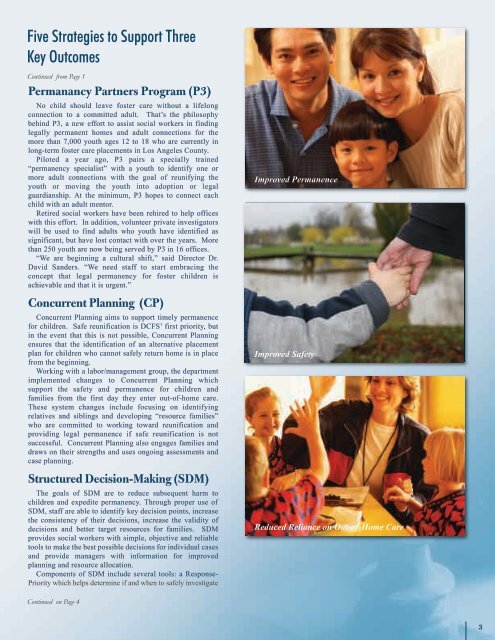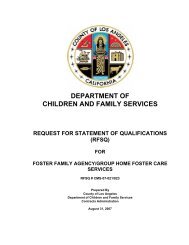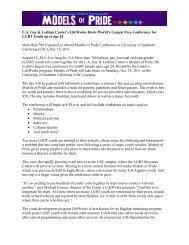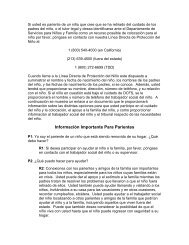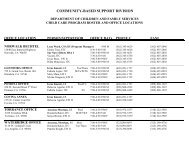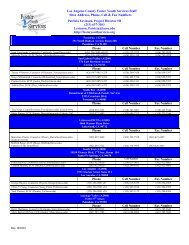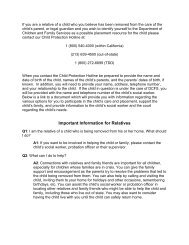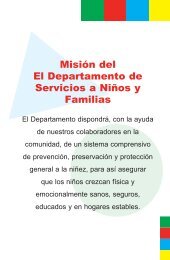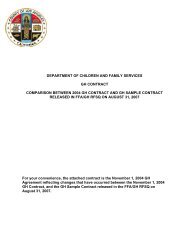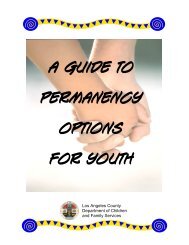DCFS News Winter Issue (PDF) - Los Angeles County Department ...
DCFS News Winter Issue (PDF) - Los Angeles County Department ...
DCFS News Winter Issue (PDF) - Los Angeles County Department ...
You also want an ePaper? Increase the reach of your titles
YUMPU automatically turns print PDFs into web optimized ePapers that Google loves.
Five Strategies to Support Three<br />
Key Outcomes<br />
Continued from Page 1<br />
Permanancy Partners Program (P3)<br />
No child should leave foster care without a lifelong<br />
connection to a committed adult. That’s the philosophy<br />
behind P3, a new effort to assist social workers in finding<br />
legally permanent homes and adult connections for the<br />
more than 7,000 youth ages 12 to 18 who are currently in<br />
long-term foster care placements in <strong>Los</strong> <strong>Angeles</strong> <strong>County</strong>.<br />
Piloted a year ago, P3 pairs a specially trained<br />
“permanency specialist” with a youth to identify one or<br />
more adult connections with the goal of reunifying the<br />
youth or moving the youth into adoption or legal<br />
guardianship. At the minimum, P3 hopes to connect each<br />
child with an adult mentor.<br />
Retired social workers have been rehired to help offices<br />
with this effort. In addition, volunteer private investigators<br />
will be used to find adults who youth have identified as<br />
significant, but have lost contact with over the years. More<br />
than 250 youth are now being served by P3 in 16 offices.<br />
“We are beginning a cultural shift,” said Director Dr.<br />
David Sanders. “We need staff to start embracing the<br />
concept that legal permanency for foster children is<br />
achievable and that it is urgent.”<br />
Concurrent Planning (CP)<br />
Concurrent Planning aims to support timely permanence<br />
for children. Safe reunification is <strong>DCFS</strong>’ first priority, but<br />
in the event that this is not possible, Concurrent Planning<br />
ensures that the identification of an alternative placement<br />
plan for children who cannot safely return home is in place<br />
from the beginning.<br />
Working with a labor/management group, the department<br />
implemented changes to Concurrent Planning which<br />
support the safety and permanence for children and<br />
families from the first day they enter out-of-home care.<br />
These system changes include focusing on identifying<br />
relatives and siblings and developing “resource families”<br />
who are committed to working toward reunification and<br />
providing legal permanence if safe reunification is not<br />
successful. Concurrent Planning also engages families and<br />
draws on their strengths and uses ongoing assessments and<br />
case planning.<br />
Structured Decision-Making (SDM)<br />
The goals of SDM are to reduce subsequent harm to<br />
children and expedite permanency. Through proper use of<br />
SDM, staff are able to identify key decision points, increase<br />
the consistency of their decisions, increase the validity of<br />
decisions and better target resources for families. SDM<br />
provides social workers with simple, objective and reliable<br />
tools to make the best possible decisions for individual cases<br />
and provide managers with information for improved<br />
planning and resource allocation.<br />
Components of SDM include several tools: a Response-<br />
Priority which helps determine if and when to safely investigate<br />
Continued on Page 4<br />
Improved Permanence<br />
Improved Safety<br />
Reduced Reliance on Out-of-Home Care<br />
3


